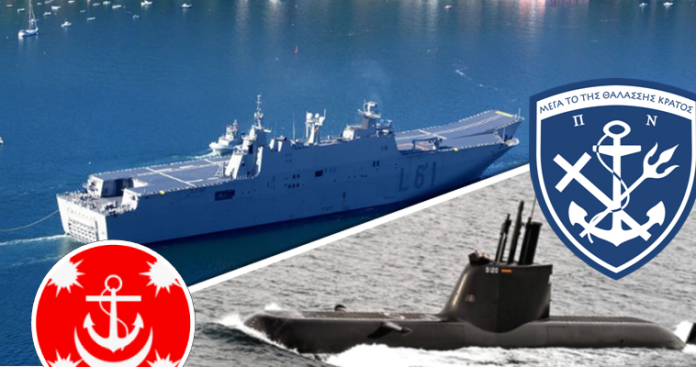Kostas Grivas: How the Aegean can become a trap for the Turkish Navy
22/09/2020
The Turkish hybrid amphibious operations ship-aircraft carrier Anadolu brings new data on the military balances in the Aegean and the Eastern Mediterranean. However, if Greece follows the current trends in the art, science, and technology of war, then it has a serious chance to turn this very expensive weapon system from a threat to an “Achilles heel” of Turkey.
Such large ships do not fit into archipelago structures, such as the Aegean, where we have a composition of land and sea in a single operational structure. In a similar area a surface ship of this size can be hit, inter alia, by missiles, attack helicopters, or fighter jets that will use islands, rocks and islets for cover until the last minute, as well as by submarines, artillery systems, and even and heavy infantry weapons, such as mortars, and guided anti-tank missiles.
This is a reality. However, the situation for surface ships in coastal waters and even more so in archipelago structures is expected to become even more dangerous in the near future. As a senior US official has characteristically stated, in the coming years there will be two types of ships near the shores: submarines and targets.
This is the result of a broader geopolitical dynamic arising from the clash of Eurasian ground forces with US air power in nearby Eurasian waters. The creation of anti access and area denial networks (A2 / AD) by countries such as China, Russia, and Iran has led to the development of similar capabilities by the United States.
This was done in the context of operational concepts such as “Cross Domain Fires”, which in turn are part of the broader doctrine of “Multi Domain Battle” of the US Army. All these battle methodologies aim at developing skills that will make the life of surface ships near the shores very difficult.
Greek underwater killers
The Greek Armed Forces already have a category of weapons systems that play a critical role in this power struggle in enclosed seas. These are the submarines, which will be called to operate in one of the best submarine action fields on the planet, the Aegean. The spearhead of the Greek submarine fleet is the four extremely quiet latest generation Type 214, class “Papanikolis” submarines, equipped with an anaerobic propulsion system (AIP), which allows them to stay for more than a week in operational dives.
Another submarine with an anaerobic propulsion system serves in the Greek Navy, the “Ocean” which is a modified Type 209/1200. However, the older 209s are also extremely dangerous, especially if equipped with new torpedoes. Of course, one of the pathogens of the Greek armaments procurement system is to procure expensive battle platforms without the right weapons for them. Submarines, then, could not be an exception to this sad tradition.
Thus, the stealth Type 214 still uses the old SUT torpedoes that have a short range and generally outdated performance. But lately, something seems to be changing. The program of supply of new type heavy torpedoes for the Greek submarines is progressing. Any of these torpedoes offers a drastic upgrade of the impact capabilities of the Greek submarine fleet, achieving a range that reaches or exceeds 50 km.
The combination of the exceptional stealth capabilities of modern Greek submarines, the anaerobic propulsion systems that allow to stay for long periods of time underwater and long-range torpedoes with advanced passive sonar, makes the Greek submarine fleet an ideal antidote not only to the hybrid Turkish aircraft carrier, in the Aegean, but also in the Eastern Mediterranean.
Autonomous super-torpedoes and mutant artillery
In recent years, in fact, torpedoes have appeared that achieve extremely long ranges, a fact that partially “emancipates” them from submarines and even offers them capabilities of autonomous action in small sea areas. A typical example is the long-range (ER) version of the German torpedo Sea Hake Mod 4. The candidacy of the simple version is being considered by the Greek Navy, while it is already serving with Turkey.
The torpedo achieved an impressive range of 140 km in tests in 2012 in the Baltic. Given the developments that have taken place since then in the technology of batteries and other subsystems, it is possible that the range has increased further. The potential of such weapons is enormous. Quite simply we can say that a similar weapon can be launched off the coast of Attica and attack targets off the coast of Asia Minor or vice versa of course.
Also, the existing artillery systems of the Greek Army, equipped with the appropriate ammunition, can change the power balance in the Aegean. For example, guided missiles are already being developed for the American M270 MLRS (GMLRS ER) multiple rocket launcher, which has been serving in the Greek arsenal for years.
These rockets are expected to be put into service soon and will achieve an impressive range of 150 km. Equipped with thermal or other sensors that allow them to independently detect targets, they will also aim at attacking surface targets, as required by the operational concept of “Cross Domain Fires”, mentioned above.
The Israeli company IMI also installs the EPIK (Electro-Optical Precision Integration Kit) system on existing 122mm rockets, which allows the rockets to detect targets, including surface ships, and to target them autonomously. A significant stock of similar rockets already exists in the Greek arsenal and is used by multiple RM70 rocket launchers of Czechoslovak origin. By the way, it is almost certain that similar conversions can be made by Greek state and private companies, without necessarily resorting to foreign know-how.
The asymmetric threat of speedboats in the Aegean
In addition, small speedboats equipped with small missiles capable of striking targets off-line-of-sight (NLOS and BLOS respectively), taking advantage of the Aegean archipelago structure, can pose a deadly danger to surface ships. These missiles are essentially improved versions of long-range anti-tank missiles. One of them is the Israeli Spike NLOS, which achieves a range of 25 km and for which the information was circulated that they will be bought by Greece.
The missile communicates by radio link with the handler, who sees the image provided by the missile’s camera, thus being able to select targets and guide the missile until the last moment. Another Israeli missile is the Nimrod 3 with a range of 50 km, but with semi-active laser guidance (SAL). That is, someone in the target area is required to “illuminate” the target with a laser pointer, guiding the missile.
An even more sophisticated system in this category is the Serbian ALAS-C fiber optic guided missile, which is expected to reach a range of 50 km. The fiber optic cable offers the user the ability to search for targets and guidance until the last minute, without the risk of interference . Finally, the most impressive relevant system that has appeared is the Russian Germes (Hermes) produced by KBR, a version of which achieves the impressive range of 100 km, but for which there is not much information. Similar rockets can be mounted on land platforms, even on agricultural platforms or helicopters.
In any case, in the international market there are low cost weapons systems that can even “button” on existing platforms of the Greek army and turn the Aegean and much of the Eastern Mediterranean into a death trap for surface ships and especially for such a large platform as the Turkish amphibious operations-aircraft carrier hybrid ship. This, of course, in case Greece wants to make some basic moves to strengthen its combat capabilities and most importantly not to return to the era of informal “donations” to foreign companies, buying expensive platforms without weapons!





